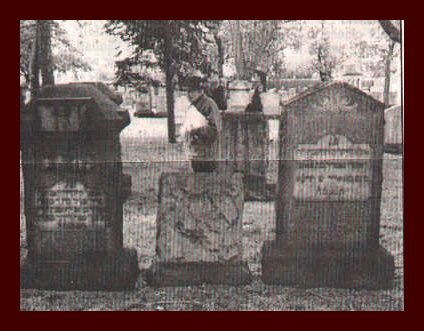The Citizen Newspaper Hamtramck, Michigan September 2000 Reprinted with permission |
Special visit On
Sunday visitors got a rare glimpse of the Beth Olem Cemetery, which is
open only twice a year to the public. The cemetery, located inside GM's
Poletown plant, is one of the oldest Jewish cemeteries in the state.
Gone, but not forgotten…By
Charles Sercombe One
of Hamtramck’s hidden treasures was opened to the public on Sunday. Visitors
got a rare glimpse of one of the oldest Jewish cemeteries in the state,
located within the GM Poletown plant. The
Beth Olem Cemetery is open only twice a year, on the Sundays before Rosh
Hashannah and Passover. Jewish leaders said that usually a handful of
people visit the cemetery, but this year about 200 came to visit. The
increase in visitors comes at a time of renewed interest in Jewish
heritage. Hamtramck
was once a bustling retail and manufacturing center where a number of
Jewish business owners flourished. The cemetery dates back to 1862 and
the last burial was in 1948. Beth
Olem (which means “house of the world”) at one time was next door to
the sprawling Dodge Main plant. That
plant was demolished in the
early 1980’s and made way for GM’s Poletown plant, which engulfed
the 2.5 acre cemetery. State law prohibited the removal of the cemetery,
so GM was obligated to let it remain. Over
the years, a number of the gravestones weathered, forever wiping away
the names of some of the deceased. According
to surviving records, there are 1,400 people buried here. Sunday’s
visitation featured a moving ceremony by Rabbi Steven
Weiss of Congregation Shaarey Zedek. Included in the ceremony
were family members of some of the deceased buried in the cemetery. Sunday’s
beautiful fall, sunny sky was a picturesque backdrop for the cemetery’s
park-like oasis in an otherwise non-descript industrial setting. The
age of the gravestones and weathering is what attracts the visitor’s
eye, offering a fascinating look at Detroit’s Jewish history. At one
time, this cemetery was considered a remote location from the Jewish
community, which was then mostly located in the downtown area. The
Jewish community moved on and out of Detroit to the suburbs, leaving
behind this little cemetery, which fell victim to vandals. But a series
of caretakers rescued Beth Olem and continue to maintain it. For
Hamtramck history buffs, the cemetery offers some possible clues to the
city’s beginnings. You’ll see gravestones with some familiar names,
names that are possibly the source of some city streets here, such as
Jacob, Miller and Mitchell. There
are also two gravestones for Zussman family members, but it’s not
clear whether they are related to Hamtramck’s World War II hero, Lt.
Raymond Zussman, who was awarded the Congressional Medal of Honor for
his heroics on the battlefield. (A park across from Hamtramck City Hall
is named after Zussman.) Visiting
on Sunday, one could overhear a number of stories about the Jewish
community that once lived and worked here. Rabbi
Weiss noted that it’s important for the Jewish community to visit
cemeteries like Beth Olem. “We must show that we will never forget,” Weiss said.
A piece of history
A visitor to Beth Olem Cemetery looks at some gravestones, many of
which date back to the late 1800s. |

